#ayyar
Photo

My debut album Meri Kahani is now live on all major streaming platforms! Experience a blend of rock, Bollywood, and instrumental fusion that tells my story. Tune in and let the music speak to your soul.
Find all the links here
https://umroayyar.hearnow.com/
#music#rock#fusion#instrumentals#guitar#electric guitar#umro#ayyar#umroayyar#musician#2024#bollywood
2 notes
·
View notes
Text
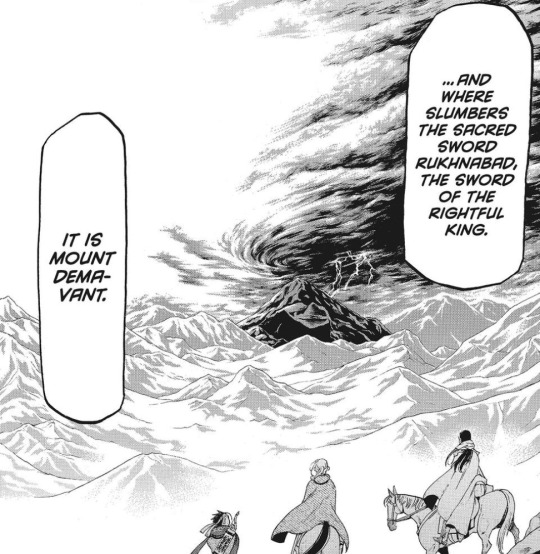
The sword of the rightful king...
Also, don't the mountains look majorly cool?
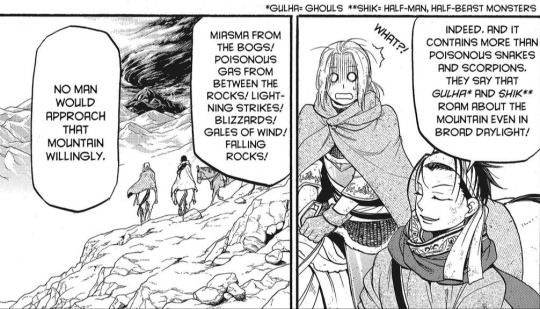
Who's willing to bet those gulha and shik were the work of Team Zahhak (pre Zahhak's fall, likely)?
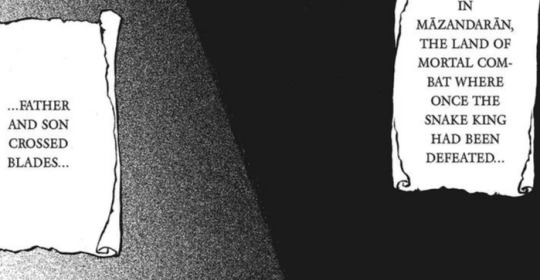
So Zahhak was defeated in Mazandaran... how tf did he end up being sealed under Mt. Demavant?? Did they transport him or???
Interesting that Kaykhusraw was slain in the same place he defeated Zahhak (since his younger son became the next Shah that's what I would have to assume: he lost).

Food ref food ref!
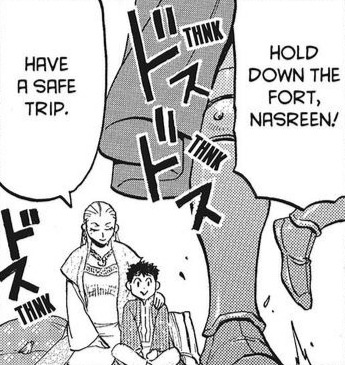
Nasreen! I really want to see more of her. From what I've seen so far she seems to be a capable and gracious lady but man I wanna know more.
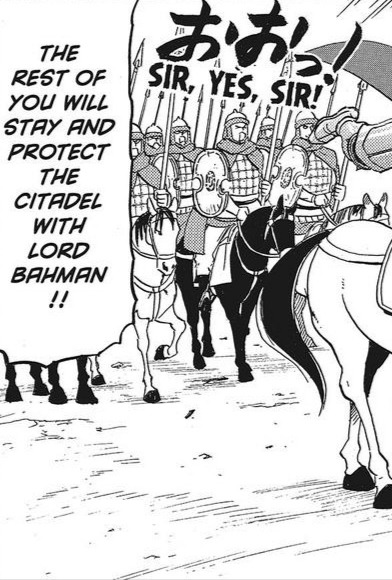
I found this cute ngl, look at one of the dudes squeezing his entire lungs to yell!

Pars is not a perfect nation and it's got somewhat of a superiority thing going on, like “you must learn my language but I don't need to learn yours to be educated” type deal, likely common within the upper classes. It manifests in even good people. Brain is not cooperating but yeah. Wanted to point this out.
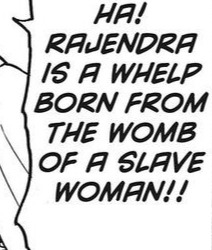
Slavery exists in Sindhura. Interesting. Iirc South Asia had (has?) a caste system thing which I need to learn more about. Have been meaning to but I kept putting it off—
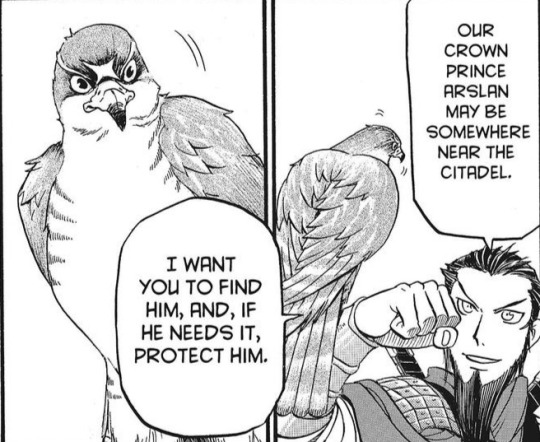
I swear to Buddha this bird has above-normal intelligence. Love you, Azrael.

I didn't screencap it but there was another instance of her saying she'll stab Hilmes through the heart, the wording specifically included the word “swiftly” iirc, even in vengeance she wants to give him a quick death— she's not interested in drawing it out or torturing him, which is a contrast to Hilmes who uh, has a sadistic trend going on. It isn't enough that Andragoras and Arslan die, they need to suffer as they do. Suffer the way he did. His anger really is... something else.
#arslan senki#the heroic legend of arslan#heroic legend of arslan#arslan senki reread#kishward#nasreen#nasrin#ayyar#alfarīd#hilmes#alfreed#arslan#gieve
14 notes
·
View notes
Text




The space police are recruiting some interesting types aren’t they?
2 notes
·
View notes
Text

New review! The Dos and Donuts of Love by Adiba Jaigirdar, narrated by Priya Ayyar
#book#books#LGBTBooks#lgbt#sapphic#BookLover#BookAddict#BookRecommendations#wlw#SapphicReads#BookReview#lesfic#Adiba Jaigirdar#Priya Ayyar
0 notes
Text
As a brown queer kid from a traditional religious family, I love stories by Adiba Jaigirdar, in general.
I love them even more on Audible because the narrators (especially Priya Ayyar) have brought to life the distinctive accents from these multicultural stories beautifully.
I’m currently listening to A Million to One (something like Ocean’s Eight meets Titanic) and The Dos and Donuts of Love (which is more like her earlier stories The Henna Wars and Hani and Ishu’s Guide to Fake Dating)
1 note
·
View note
Note
I know we're on severely limited data considering only Manuchurh appeared before a sizable chunk of soldiers BUT seeing their reaction for him seemingly returning... made me think he surely must've been well-loved? 👀
Yeah, I think so. The sight of any Marzban who had been thought dead is likely to be a huge morale boost and cause of joy for the Parsian soldiers (see the reaction to Kubard's arrival in Peshawar) but I wouldn't be surprised if Manuchurh in particular was well-regarded. The few details that are mentioned about him in the novels come well after his death, but I actually went digging for that part just now so here's a very rough translation:
'Although Manuchurh was already fifty years old when he died during the first Battle of Atropatene, according to the surviving soldiers, he sent close to twenty Lusitanian soldiers to the underworld before he perished. Not only was he a master of archery, horsemanship and swordplay, but he was also expert at sieges and field battles; an archetypical Parsian warrior. Even calligraphy of the Parsian language posed no problem for him. In addition, he had a clear and beautiful voice. On more than one occasion, Andragoras III had ordered him to read aloud declarations of war or peace edicts. Therefore Ayyar*, who inherited this bloodline, was also famous for his loud crying.'
(Book 11, Chapter Three, part ii)
* in case anyone doesn't remember, Ayyar is the son of Kishward and his wife Nasrin (who is Manuchurh's daughter)
#arslan senki#the heroic legend of arslan#manuchurh#(my random headcanon for this guy is that he commanded a unit of heavy cavalry)
26 notes
·
View notes
Text


Aldric Ayyar, aberrant mind sorcerer for a new D&D campaign! The root/antler-like growths give him a hard time but hey, they come with neato psionic powers so it can't all be bad right?
I've not played any sorcerer before so I'm really looking forward to mucking around with metamagic and especially casting spells on the downlow with the Psionic Sorcery feature! But I am not looking forward to a d6 hit die, no armour, and no AC lol. Poor guy dumped DEX.
And some bonus development sketches, despite trying to plot them all out I'm certain the antlers will change every time I draw Aldric lol. He has some pain/weakness in his hip so uses the cane to get around, and some prosthetics and braces to help with other effects of the mutations.



145 notes
·
View notes
Note
ARABIC SONG LINKS PLSS

UMMM OKOK I’LL GIVE U A LARGE VARIETY AND U TELL ME WHICH U LIKE
majid almohandis - bdet ateeb
majid almohandis - tenadeek
majid almohandis - ameera
hussain aljassmi - habibi barsheloni
hamaki - baeit maah
adel ibrahim - ah ya london (ppl say this one’s overrated but idc)
abdul majeed abdullah - ya ibn alawadem
abdul majeed abdullah - enti wbas
abdul majeed abdullah - ghazal ma yensady
rashed al majed - ya sareq el-qalb (personally don’t like the version with the girl, but u can listen to that if u want)
shams - atoq esbaa
salim salem - al jassmi
salah al zadjali - ayyar
fadel shaker - maool
zekra - min natharta
mohamed alsalim - qalb qalb
hossam al rassam - ghalat omry
#u can tell what kind of arabic music i like the most#ok but the vocals + the lyric meanings are TOP. TIER.#anon i urge u to look at the translations#if you cant find a song bc the titles are only in arabic then js send me another anon or smth and i can find u a link
3 notes
·
View notes
Text
Nestaway’s Insider Guide: Top 4 Family-Friendly Neighbourhoods in Chennai
Chennai, often dubbed the "Gateway to South India," is a city where history and modernity coexist in perfect harmony. It is a city that provides citizens with a good quality of life because of its rich cultural heritage, elegant temples, and perfect beaches. If you and your family are thinking of relocating to Chennai, there are a number of important things to take into account when renting accommodations through the Nestaway platform. Apartment rentals in Chennai are impacted by their location, connectivity, and security. Using the Nestaway good platform, you can choose a family-friendly property in Chennai in an area that exactly aligns with your needs. These areas give close access to prestigious schools in addition to accommodating your job convenience. You can securely explore these localities for your Chennai house rental with Nestaway, ensuring a smooth transition.

Adyar
Adyar is a serene residential neighborhood located along the southeastern coast of Chennai, bordering the Bay of Bengal. Adyar is well-connected to major roads like the East Coast Road and Old Mahabalipuram Road, ensuring smooth travel within Chennai. Adyar is reachable via the city's suburban rail network due to the presence of its own MRTS railway station. This place is home to a number of reputable schools, notably the Bala Vidya Mandir Senior Secondary School, and Abacus Montessori School. Also, this locality is an appealing choice for professionals in the IT industry due to its closeness to the OMR IT corridor and Tidel Park. Furthermore, its proximity to the Adyar River and the Theosophical Society increases its appeal. Adyar is renowned for its safety. With a strong sense of community and well-guarded streets, it offers families a safe environment. Being a reliable source, the Nestaway platform can help you learn about Adyar’s residential and educational advantages, making it a good fit for your family's requirements.
Anna Nagar
A well-planned residential neighborhood, Anna Nagar is located in Chennai's northwest. Ambattur and Guindy Industrial Estate, Chennai's well-known job hubs, are easily accessible from this region because of the area’s outstanding connectivity to major routes such as Anna Arch flyover and the Inner Ring Road. Additionally, as displayed on the Nestaway reliable platform, Anna Nagar residents enjoy easy access to prestigious educational institutions, including SBOA Matriculation and Chinmaya Vidyalaya. The neighborhood also boasts of having its own metro station, which provides easy access to other parts of the city. Moreover, Anna Nagar is regarded as one of Chennai's safest areas, with well-lit streets and a vibrant neighborhood. You can trust its safe and secure environment.
Velachery
Velachery, in South Chennai, is the biggest commercial center in this region of the city and is a booming center for both business and residence. This neighborhood holds distinction from other rental localities in Chennai because of its affordability and well-known transit system, which includes Velachery Main Road and the Inner Ring Road. This benefit is further enhanced by Nestaway. This region is a great alternative for professionals because it is in proximity to well-known IT parks, like Tidel Park and Ascendas IT Park. This area is also renowned for having some of the best educational facilities, including The Ashram Matriculation Higher Senior Secondary and D.A.V. Public School.
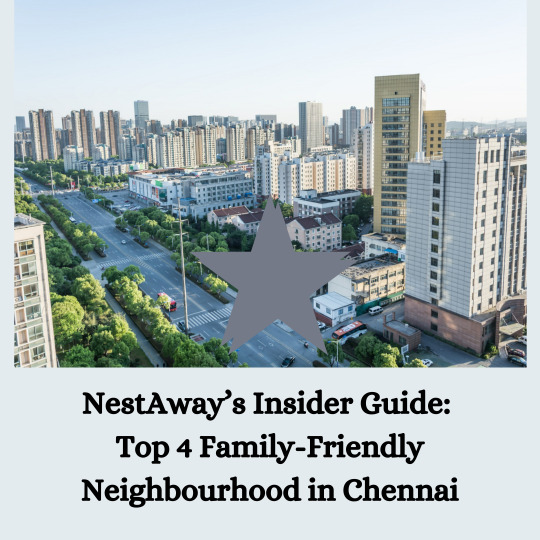
Mylapore
Mylapore, as highlighted through the reliable Nestaway platform is a locality located in the heart of Chennai. It is a very historic and culturally significant neighborhood. Mylapore has great access to well-developed roads, in addition to its proximity to major transport hubs like Chennai Central railway station. Some of the best educational institutes, including Lady Sivaswami Ayyar Girls' School and Vidya Mandir Senior Secondary School, are easily accessible in this locality. The city's primary commercial areas and workplaces are also well connected to Mylapore. The Nestaway reliable platform ensures that you can learn about the many beneficial features of the locality and can book affordable accommodation here.
Conclusion
Chennai serves as a vibrant example of the evolving urban landscape of India with its rich cultural legacy, modern infrastructure, and diverse people. This dynamic city beautifully blends history and innovation, providing its people with a comfortable life. By relying on Nestaway's good ratings and Nestaway reviews, you can comfortably make well-informed financial decisions in Chennai's growing rental real estate market, where families often relocate for greater opportunities. It doesn't matter if you are a student or a working professional; Chennai will take care of your needs. As a student or a working professional, Nestaway will assess your rental and other costs. With the help of the Nestaway platform, you can estimate your rental costs while taking your particular needs into account. You have a choice of a plethora of options that are also pocket-friendly. It also facilitates a variety of rentable processes that enable accommodation in Chennai. Nestaway is backed by a variety of positive Nestaway review and Nestaway ratings.
#nestaway#nestaway ratings#nestawayreview#nestawaygood#nestaway platform#nestaway reliable#nestaway reviews#nestaway good#nestawaypune#nestaway review
4 notes
·
View notes
Text
THE STORY OF MAMANKAM Part 3/3
These articles quote a lot from K. V. Krishna Ayyar's The Zamorins of Calicut and Wikipedia (which again uses the aforementioned text as the main source). So all credits go to K. V. Krishna Ayyar and the Wikipedia contributors.
Samoothiri - Zamorin, the King of Kozhikode
Valluvakonathiri - The King of Valluvanadu
1. The Legend of the Cheraman Perumal
2. Mamankam During the Reign of Samoothiri
3. Chavers of Valluvanadu
When Samoothiri conquered Valluvakonathiri, all other kings of Kerala were obliged to send flags of submission (adimakkodi) to Thirunavaya. But Valluvakonathiri refused to acknowledge Samoothiri as the legitimate Rakshapurushan (Great Protector) of Mamankam. He used to send chavers (suicide warriors) instead.
If these men could kill the Samoothiri who was personally present at the fair under the protection of his own forces, the privilege of Great Protector might have returned to the Valluvakonathiri. But no Samoothiri in history was ever killed by a chaver. Chavers and Pantheerayiram (the bodyguard of the Samoothiri) were considered the property of their respective kings and kingdoms.
Kudippaka or blood feud was prevalent in the medieval Kerala society. If a warrior was killed, it was considered the duty of his king and the subsequent generations of the deceased to avenge the death. Chavers were led by warriors from one of the four major Nair houses of Valluvanadu - Putumana, Chandrothu, Vayankara, and Verkotu. Other than these four main families who would lead the suicide warriors, fourteen other families too would send chavers. Often, Muslims too supported Chavers.
Chavers preferred death to defeat. No chaver has ever come back from Mamankam. Once, a Puthumana Panikker couldn't cross the Pantheerayiram but the Pantheerayiram couldn't kill him either. Panikker begged to Samoothiri's forces to end his misery but they were scared of him. No one has seen the great warrior again.
Those who decide to partake in this suicide mission would first go to Thirunelly and finish their own funerary rites (and their mothers' too if they didn't have other sons) even when they were alive. After this, they would visit Thirumandhamkunu bhagavati (the tutelary goddess of Valluvakonathiri), bathe in the temple pond and meditate for forty-one days on the Chaver thara ("platform of the martyrs"). Samoothiri's bodyguards too conducted similar prayers, reiterating their oath to the king.
After completing their meditation, Chavers went to Puthumana home. After washing their feet on the stone floor, they would be served their last meal, rice mixed with coconut oil and salt, by Puthumana Amma (the eldest lady of the family) who was considered the sister of Valluvakonathiri. They would leave for Thirunavaya after praying at Puthumana kalari (dojo).
On each day of Mamankam, they would fight their way through heavy security to the Nilapadu thara. Needless to say, all of them were slaughtered by the bodyguards who too were mowed down by Chavers without any mercy. After Samoothiri returned to his residence everyday, the bodies of chavers would be dragged by elephants and immersed in a well known as Mani kinar.
Despite the seemingly impenetrable security, Samoothiri came dangerously close to death twice. Two teenage chavers, Puthumana Kandaru Menon and Chandroth Chanthunni managed to bypass the 12,000 and reached Nilapadu thara on seperate years. Chandrothu Chanthunni almost decapitated the Samoothiri but his sword was stopped by a big bronze lamp.
The Mamankam fest came to an end with the conquest of Kozhikode by Ḥaidar Ali and the subsequent Treaty of Seringapatam with the English East India Company.
4 notes
·
View notes
Text
tagged by: @deerfests. Thank you, friend!
last song // Little Piggy by Rob Zombie
last show // I think the last series I actually finished was Bordertown (2016, Netflix)?
last movie // Fall (2022)
currently watching // So much. Primarily trying to get through Beastars (2021, Netflix) though. Slooowly but surely.
currently reading // Samak the Ayyar: A Tale of Ancient Persia, also slowly but surely. Like, two years slowly. I don’t read nearly enough these days.
current obsession // Prince of Persia is always at the forefront, but there’s also Alan Wake, and Klaus (2019, Netflix) lives in my head absolutely rent free. Little sprinkling of Legacy of Kain and Okage: Shadow King in there, too.
tagging: anybody!
2 notes
·
View notes
Text
Ahenk Taşı
Bir ömür geçmiş üstümüzden bir ışık yassı
Bir ömür üstümüzde nice boşluklara yatsı
Bir gönül vermiş izinde nece biter Kasım
Bir gönül koymasa da iyice sararır esasım
Bastığın her toprak abluka altında kayıp
Sanki göğsümde uyuşuk her ahenk taşın
Aşk bu, yükseklik biçmez asla sırnaşık
Aşk, bir ayyar gibi çarnaçar bırakıp
Üzerime bu revayı an be an yazın
Dehada bir eda bulamamışsa algın
Daha da bir söze varamamışsa alın
Sensiz nasıl yol alabilir ki yazgım?
0 notes
Text

Narsus very likely knew that Rajendra would send info about the Parsians to Gadhevi, and acted accordingly to confuse the enemy and prevent Gadhevi's army from descending upon them full-force. Oh Rajendra, I like you but you deserve a whack in the head.
This arc reminded me how much I loathed Gadhevi.

So this is how Jaswant looks without his headscarf! I have nothing interesting to say, I just wanted to put this picture here.
And oooh is that written Sindhuran script!!!


That's a whole lotta supplies! I suppose they might come from the lands surrounding Peshawar? Collected as tax? Maybe? Or something else? I don't know.
Wondering if in Wolfpack AU Gorgan could also send supplies to aid Peshawar and the folks on the Sindhuran campaign.

Karikala gon be mad envious at a certain father who managed to raise his kids to be thick as thieves in Wolfpack. Poor guy though, he looks so tired.

Poor Narsus. I want to see him cry.

More flags for the Turanian invasion to be bumped up in the Wolfpack timeline, fucking hell.
Unfortunately I know nothing about Turk.

Okay so where is Bahman's family? In Peshawar just like Nasrin and Ayyar?

Are those two women part of Bahman's family? They don't look like household staff, at least not judging from their clothes. Does Bahman have any children? A son? I wish we knew more about various characters' families and such. Zandeh's mother. Alfarīd and Merlaine's mothers. Zaravant's family. Does Lushan have a family? I wanna knoooooooow

Extra sketches to finish this post off!
#arslan senki#the heroic legend of arslan#heroic legend of arslan#wolfpack au#winds of wolfsong#arslan senki reread#gadhevi#rajendra#karikala#jaswant#bahman#nasrin#ayyar
2 notes
·
View notes
Text
İnegöl Belediyesi şehir tiyatrosu yaz turnesinde
https://pazaryerigundem.com/haber/186548/inegol-belediyesi-sehir-tiyatrosu-yaz-turnesinde/
İnegöl Belediyesi şehir tiyatrosu yaz turnesinde

İnegöl Belediyesi Şehir Tiyatrosu, yaz turnelerine komşu ilçelerle devam etti. Orhangazi ve Keles’te yapılan programlarda Ayyar Hamza tiyatro gösterisiyle Karagöz Gölge Oyunu izleyici ile buluştu.
BURSA (İGFA) – Şehrin kültür sanat hayatına yön veren İnegöl Belediyesi’nin şehir tiyatrosu ekibi, yaz aylarında farklı şehirlerde de gösterimleriyle sanatseverlerle buluşuyor. Bugüne kadar pek çok oyunla izleyici karşısına çıkan, şehir şehir gezerek hem İnegöl’ü tanıtıp hem de ülke vatandaşlarını sanatla buluşturan İnegöl Belediyesi şehir tiyatrosu, iki komşu ilçeye oyunlarıyla misafir oldu.

İnegöl Belediyesi Şehir Tiyatrosu, Keles ve Orhangazi Belediyelerinin daveti üzerine bu iki şehre misafir oldu. Ayyar Hamza oyununda; Volkan Derman, Ensar Ağız, Semih Evren ve Güven Kadircan sahne alırken, Arda Aki, Ahmet Şentürk, Seracettin Dengiz, Rüstem Ahmet Gözübüyük, Serra Şahin, Zeynep Aygün, Nehir Uzun ve Fatih Uysal sahne aldı. Karagöz Gölge Oyunu ise hayali Volkan Derman, yardak Ensar Ağız tarafından sahnelendi. Şehir Tiyatrosu ekibinin sergilediği geleneksel Türk Tiyatrosunun en güzel ve en eğlenceli örneklerinden biri olan “Ayyar Hamza” oyunu ile Karagöz Gölge Oyunu, Keles ve Orhangazi’de vatandaşlardan yoğun ilgi ve büyük beğeni gördü.

BU Haber İGF HABER AJANSI tarafından servis edilmiştir.
0 notes
Text
Bella Ciao in Old Babylonian: "Lūtalak dādī"
The following is my attempt to translate Bella Ciao from the original Italian into Old Babylonian Akkadian from one or two years ago:
Luttalak dādi
1.
ina ṣīt Šamšim / anāku atbē,
luttalak, luttalak, luttalak, dādī!
ina ṣīt Šamšim / anāku atbē
ana nakrim maḫārim.
"At sunrise, I arose,
"I must go, I must go, I must go, my darling!
"At sunrise, I arose
"To meet the enemy."
2.
qurādum, aḫī, / aḫāka šūbil,
luttalak, luttalak, luttalak, dādī!
qurādum, aḫī, / aḫāka šūbil,
ana mūtim qerbēku.
"Oh hero, my brother, bring my brother,
"I must go, I must go, I must go, my darling!
"Oh hero, my brother, bring my brother,
"I am close to death."
3.
šumma addīk / ina qāt nakrim,
luttalak, luttalak, luttalak, dādī!
šumma addīk / ina qāt nakrim,
atti, dādī, qibrīni!
"If I should be killed by the enemy's hand,
"I must go, I must go, I must go, my darling!
"If I should be killed by the enemy's hand,
"You, my darling, bury me!"
4.
ina šaduī / qarbam petīam,
luttalak, luttalak, luttalak, dādī!
ina šaduī / qarbam petīam,
ina ṣilli ayyarim.
"In the mountains, open me a grave,
"I must go, I must go, I must go, my darling!
"In the mountains, open me a grave,
"In the shade of a flower!"
5.
u ša qarbī / ītenetteqū,
luttalak, luttalak, luttalak, dādī!
u ša qarbī / ītenetteqū,
umma: 'ayyarum damiq.'
"And those who pass by my grave,
"I must go, I must go, I must go, my darling!
"And those who pass by my grave,
"Will say: 'The flower is beautiful.'"
6.
ayyarum annûm / ayyar qurādim,
luttalak, luttalak, luttalak, dādī!
ayyarum annûm / ayyar qurādim
ša maksîni ipṭaru.
"This flower / is the flower of the hero,
"I must go, I must go, I must go, my darling!
"This flower / is the flower of the hero,
"Who resolved our bondage."
Two notes: The central issue in translating Bella Ciao was translating that very phrase itself since Akkadian often does not readily lend itself to mono- and bisyllabic words. Furthermore, we are lacking a lot of everyday words and phrases, like: How would one say goodbye? Eventually, I decided on the verbal form luttalak "I will / must go away", which just like bella ciao has three syllables. Because it wouldn't have made sense to repeat the last syllable at the end of the verse mirroring bella ciao, ciao, ciao, I added a second word, dādī "my darling".
Another issue is, of course, vocabulary: Words like partigiano, invasor "invader", or libertà "freedom" do not have clear Akkadian counterparts. The former I translated, depending on the number of syllables I needed, as qurādum "hero" or aḫum "brother", for invasor I chose the more general nakrum "enemy". Libertà "freedom" I ended up translating much more concretely as maksî paṭārum "to remove shackles".
Edit (04 Aug 2024): I changed the last line of verse 2 from aššum mūtam qerbēku "for I am close to death" to ana mūtim qerbēku "I am close to death". In the former translation I assumed without reason qerēbu "to be close to" could take an accusative object; this has now been corrected.
#bella ciao#akkadian#babylonian#luttalak dādī#anachronistically translating songs into ancient languages
1 note
·
View note
Note
Does give and farangis have a good ending together?
(Ah, it's taken me a long time to get around to answering this ask, sorry about that!)
This is definitely spoilery so I'll hide it under a Read More, please don't look if you wish to avoid novel spoilers.
They do both survive the big battle in Book 16.
For some context, after the final battle, Pars ceases to exist as a unified country, along with Turan, Turk, Misr, Maryam and Lusitania (these countries all lost their rulers and became divided into smaller contested territories, falling into a 'dark age' where there was no central power or stability).
The Parsian refugees end up living in Sindhura, where they occupy an area / settlement known as Parstan. Farangis, Gieve and Elam travel there in accordance with Arslan's wishes, arriving in the 6th month of Year 326 and breaking the news of Arslan's death to Rajendra.
I'll do a little bullet point list of any details Tanaka gives about Gieve and Farangis after that:
There are initially about 500 Parsians living in Parstan (though the population does grow as more refugees arrive). Nasrin is the region's representative, assisted by Farangis. Gieve and Elam are in charge of the military and investigating the situation in Pars
Gieve apparently becomes less talkative, and seems to shy away from his usual pasttimes with women, saying by way of explanation that he's 'tired of it'.
In Year 327, Gieve and Elam help Rajendra out in a military excursion to the southern part of Turk, but although they are willing to help out in the future, they refuse to become generals of anywhere but Pars (this rejection pisses Rajendra off, but thankfully Salima speaks sense and they end up giving Parstan money for a school and a medical facility instead).
Both Gieve and Farangis help out with raising Ayyar, Kishward and Nasrin's son (the timeline has reached Year 330 by the time this has been mentioned, but it gives the impression they've been doing this consistently over the years as he's grown). Gieve instructs him in archery and sword skills, and Farangis is responsible for his education.
Farangis also gives guidance to Tus's three wives, who refine their skills with bow and sword and help out with working to guard Parstan.
In Year 336, Gieve passes away. This was shortly after returning from an expedition to the East with the Sindhuran army, where once again he distinguished himself by felling several enemy generals with his bow. However, the Parsians were not used to the climate and jungle conditions in the East, and many soldiers from Parstan died during this expedition. Gieve also fell victim to this, dying of a mosquito-borne disease that caused repeated episodes of high fever.
Since you seem to be specifically interested in Gieve/Farangis, here's a rough translation of his last words:
'Knowing that he was about to die, Gieve spoke to Elam from his sickbed.
"I leave my bow to Ayyar. The sword is for you. My oud is yours for safekeeping; if you run into someone celebrated enough to match it, hand it over to them."
"What will be left for Lady Farangis?"
After Elam's question, Gieve's face showed the sort of impudent smile that had not been seen in a long time, but when he replied his voice was a low whisper.
"My heart."
He was thirty-eight years old, though as there was only his word to go on, it was unclear whether this was true or not. His identity before serving Arslan remained unknown.'
sad Gieve feelings being experienced
After the deaths of both Ohrul and Gieve, Farangis presided over their funerals. (Ohrul was a little girl rescued by Jimsa, later adopted into Kishward's family.)
Elam was very concerned about the question of whether Gieve and Farangis had been married, but since both of them had remained silent, the matter remained unknown to to the end.
Shortly after Gieve's death, Farangis resigned from her position as Nasrin's assistant and built a small temple of Mithra where she lived in seclusion. Even so, she still responded to Nasrin's occasional requests for advice and continued to teach Ayyar, but died of an unspecified illness in Year 345 at the age of forty-eight. She remarked to Elam that it had been a 'truly interesting life.'
It does feel like Tanaka is indicating that the two of them being together was a possibility. Before Book 16, my thoughts on Gieve/Farangis were 'nope, I only ship it in sahari's Coronation' but this changed my mind. The exact nature of their relationship may be unknown, but it seems as though there were genuine feelings there.
(Elam's concern over whether they were together reminded me of the scene in Book 15 where, after Narsus and Alfarid are killed, Arslan asks Farangis whether they were married. She answered that yes, they were. It's clear that even though they hadn't had the official ceremony yet, in their hearts they had already made that committment to each other.)
As always, I'd love to hear what others think. How do you think Farangis and Gieve saw each other in their hearts by the end of the series?
23 notes
·
View notes